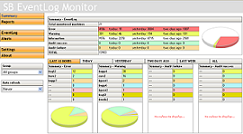 I have only one thing to say about this product, “How did I ever live without it”. If you manage more than one Microsoft Windows Server then you definitely need to be using SB EventLog Monitor.
I have only one thing to say about this product, “How did I ever live without it”. If you manage more than one Microsoft Windows Server then you definitely need to be using SB EventLog Monitor.
So what does SB EventLog Monitor do that is so great, it collects, collates, and reports via a web interface upon Microsoft Event Log data. The UNIX world has had syslog forever and a ton of tools to help you manage the logging data generated by servers. I’ve even tried to shoehorn Microsoft Event Log data into some of those products, but it was never a good fit. SB EventLog Monitor allows you to quickly and easily manage and analysis what is going on across all of your servers. It allows you to quickly and easily view and filter error messages from different servers and identify patterns. This is particularly useful with dealing with multiple servers across slow WAN links.
It collects the Event Log data either via a Microsoft VB script that use WMI to collect only the new events or via an agent that you can install on your servers. The other requirements are MySQL, PHP (5.0+), and a web server (apache, IIS). While the install is geared towards running everything on a Microsoft server it is possible to run the database and web server on Linux. In fact that is what I did. The install is really pretty easy, so if you are looking for a relatively simple way to increase the manageability of your servers, then I strongly recommend that you take the time to install the open source SB EventLog Monitor.
